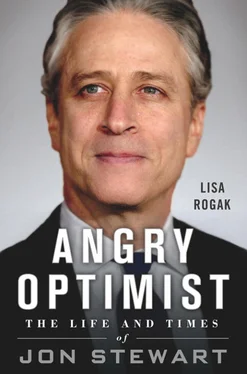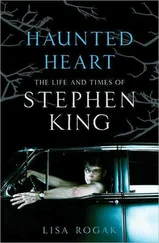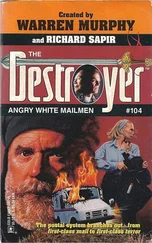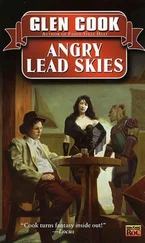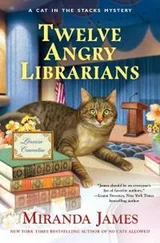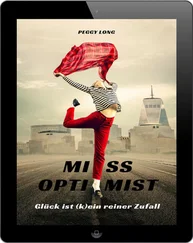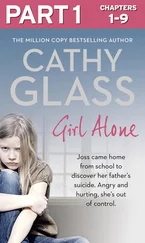“We didn’t sit around wondering, ‘How do we make a Generation X talk show?’ It just represents my sense of humor,” said Stewart. “How I am on the show is how I am, except, of course, that I’m miked.”
One look at the set and it was clear this wasn’t a typical talk show of the early 1990s. The stage set looked like it came from the back of a grubby auto mechanic’s garage, while the several black-light panels serving as backdrops were nice touches in keeping with the overall industrial theme. Stewart used a wooden tabletop hockey rink—known as Nok Hockey—for his desk, and guests perched on the front seat of an old car that had been pulled from a junkyard.
“We’re a little more casual than some of the other programs,” he added. “The pressure isn’t as harsh. People can check in and hang around. Other shows are very much in a war. We still have that annoying puppy-type quality of just being happy to be here.”
He also realized that if the program was on a more widely watched network, then he would be running a very different show. “If we were doing the show on network, we’d probably have to rein it in a little bit. We can be rougher and it doesn’t appear out of place because of the context of the channel we’re on.”
Case in point was when model Cindy Crawford appeared on the show. After he told her she had very soft skin, she pulled a vial of skin cream from her purse and proceeded to apply it to the top of his hand. When she asked him if it felt good, he replied, “I don’t know, Cindy, when I have cream on my hands, it’s usually on the other side.”
In any case, he admitted he preferred being on MTV because he wasn’t required to put on airs. “The way I dress on the show, that’s what I like, that’s how I live, except the show is cleaner,” he said. “If it were really my life, it would be me and the guest and a pile of dirty laundry next to us. And some cat litter that needs to be changed.”
Improbably, given the juvenile lead-in show, MTV believed Stewart would be able to attract a female audience to the show. “Women will love him as well, which is important because we see this as having broad appeal,” said Herzog. “He’s perfect for MTV without being too MTV.”
“We were an aberration on MTV,” said Stewart. “We actually talked to people seven minutes at a time.”
The cable channel committed to twenty-four episodes, and Howard Stern was the first guest. His book Private Parts had just been published and he was booked on the show to promote it. Stewart was a big fan and he spent hours planning his responses to every possible retort. But the interview didn’t get off to a great start.
“I don’t know who you are and you’re going to be off the air in six weeks,” said Stern. He then proceeded to criticize Stewart while the brand-new talk-show host tried valiantly to hide his shock. “Howard was just nailing me left and right, so I did the only thing I could do. I just flipped open his book and I go, ‘What’s this chapter on lesbians?’ Woo. He was off me.”
With Conan O’Brien making his debut on NBC around the same time, it was natural for critics to compare the two shows. By and large, they preferred Stewart’s approach and style as more refreshing.
“Conan’s show was billed as the voice of Generation X, so there was that expectation, but I don’t think he cuts it,” said Entertainment Weekly TV critic Bruce Fretts. “Conan’s show feels so forced, like they’re trying so hard to be hip and ironic.”
And compared with the other talk-show competitors at the time, Stewart’s show stood out for its length: it was thirty minutes while the others were an hour or more. “The whole point [is] that even when it sucks, it’s only a half-hour,” said Stewart. “So come on, they can sit through that. If they can sit through a half-hour of a Flowbee commercial, they can certainly sit through a half-hour of my show.”
From the start, the bulk of guests were bands with music videos currently on heavy rotation on MTV, which made sense given who was footing the bill. “It was important to get people the MTV audience recognized.” But at least Stewart had a passing familiarity with the bands and so could hold a halfway interesting conversation with guests.
“The bands we have on the show play the music I listen to,” he said, but as for the nonmusical guests, given that he was on a cable channel with little to no budget, he essentially had to book B- and C-level stars who were already in New York. “The guests are more of a potluck of who’s in town,” he said. “Letterman sits down to feast, and then we ask, ‘Are you gonna finish that?’”
That said, some higher-caliber celebrities did appear on the show from time to time. Both Cindy Crawford and William Shatner visited and Stewart made an effort to convince some of the stars from The Brady Bunch to come on the show. But he quickly learned that the best approach to the show was to essentially wing it, instead of scheduling it down to the second.
“You can’t plan this kind of show in advance,” he said. “We spent four months designing the show, and the first week we were on the air it was evident that seventy-five percent of the stuff we thought would work didn’t.”
The late Anna Nicole Smith also made an appearance, and her constant drug-addled state provided Stewart with a bit of amusement. “I was used to viewers falling asleep during the show, but this was the first time we had a guest do it,” he said. “I’d ask a question and then she’d begin to try to answer. About halfway through it she asked, ‘What was the question?’ When we went to commercial—I had never seen this before—she had an Indy pit crew with her. All of a sudden eight guys come out and twist her head and slap her around, and there’s one lady in the front going, ‘Come on, you can do this.’ We came back and she was a little fresher.”
Finally, after years of working the wee hours at clubs all over the country in front of drunks and hostile people, he could relax… a little. Plus, he started to be recognized in public.
“It’s completely weird,” he said. “I was at this Denny’s in New Jersey at two thirty in the morning, and a bunch of kids home from college spotted me. They were like, ‘Wow! What are you doing here in Denny’s, man? You’re on MTV!’ They just were so exuberant, it really blew me away.”
After years of obscurity and still getting booed regularly, it was taking a little bit of time to adjust to television fame.
His increased visibility put him in demand in other entertainment venues. Now that he had a TV show of his own—albeit on a cable channel—other talk shows clamored to book him as did some of the comedy clubs that had blown him off when he was unknown. Hollywood also started to consider him for movies.
And he started to phase out a vision of his future being a miserable existence that he had carried around for years: “The prophecy I’d created for myself was one room without a bathroom, [where I was] a miserable old guy who will never love or be loved.”
With his fortunes rising, he was able to upgrade from his cramped studio apartment—it was so small that, in his words, he could “touch all four walls while perched on the toilet”—to a one-bedroom in Greenwich Village. He could have moved to a much larger apartment in a more expensive neighborhood, but the experience of his parents’ divorce and the financial challenges that followed were still fresh in his mind: the rug could be yanked out from under him at any moment. So he decided to play it safe.
“This is a business built on quicksand,” he said. “But I’m trying to get more perspective and allow myself to enjoy things. Occasionally, I’ll think, gee, this really is a lot of fun.
Читать дальше
